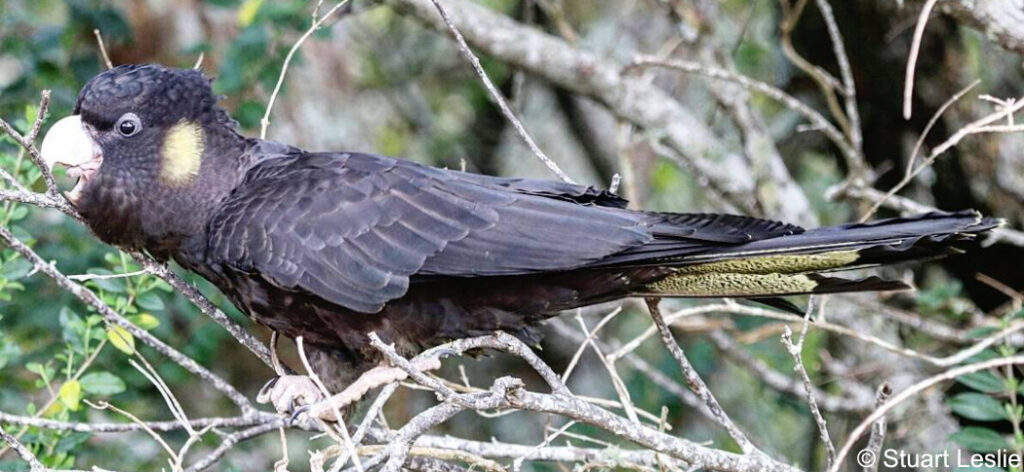Zanda funerea - Yellow-tailed Black Cockatoo
Photo: Copyright © by Stuart Leslie. See more of his photos on Instagram @skyscapes_dorrigo
The Yellow-tailed Black Cockatoo – (Shaw, 1794) – is a large brownish black parrot native to the south-east of Australia.
It is not very common in aviculture and is rare outside of Australia.
The taxonomi of this species can be a little confusing as the classification depends on which sources you are reading:
- The Yellow-tailed Black Cockatoo was first described by George Shaw in 1794, who classified as Psittacus funereus.
- In 1826 it was moved into the new Calyptorhynchus genus and reclassified as Calyptorhynchus funereus by the French zoologist Anselme Gaëtan Desmarest.
- Resent studies have resulted another move into the new genus Zanda and it is now classified as Zanda funerea. This was updated in IOC 10.2 in 2020 but other sources have used the Zanda genus for several years. For more information read this article.
The Yellow-tailed Black Cockatoo is listed on CITES Appendix II and EU Annex B.
Description
The overall plumage is brownish black with white edges resulting in a scalloped pattern. The crest is small and not as impressive as other cockatoos. The cheek patches and tail band are yellow.
The male has pinkish-red eye-rings and a dark-grey or black beak.
The female has grey eye-rings and a bone-colored beak. The tail is more spotted and the color of the cheek patches is more bright.
Length: 67 cm
Weight: 750 – 900 g
Notice the spotted yellow tail-band on this female.
Subspecies
Three subspecies are recognized by IOC – however, some sources do not recognize Z.f. whiteae and consider it part of Z.f. xanthanota:
- Zanda funerea funerea (Shaw, 1794) : They have longer wings and tails and also a darker overall plumage compared to the other subspecies. This subspecies was previously classified as Calyptorhynchus funereus funereus (notice the change in gender).
- Zanda funerea whiteae (Mathews, 1912) : Similar to xanthanota but the male beak is not as wide and the females are slightly smaller. This subspecies was previously classified as Calyptorhynchus funereus whiteae.
- Zanda funerea xanthanota (Gould, 1838) : Similar to funerea but with a much shorter tail and also smaller in size; the yellow tail band has some brown spots (sometimes missing on the male). This subspecies was previously classified as Calyptorhynchus funereus xanthanotus
Habitat
Eastern and southeastern Australia.
Three subspecies are recognized; they are native to these regions:
- Zanda funerea funerea : Eastern Australia from east-central Queensland to eastern Victoria.
- Zanda funerea whiteae : Southeastern Australia from southern Victoria to Eyre Peninsula and Kangaroo Island.
- Zanda funerea xanthanota : Southeastern Australia: Tasmania and islands in the Bass Strait. The scalloping pattern is more prominent. This subspecies was previously classified as Calyptorhynchus funereus xanthanotus
They usually live in forests or woodland but are occasionally also seen in urban areas.
Diet
The Yellow-tailed Black Cockatoo require a high-protein diet; some captive birds have produced yolk-less eggs which seem to be caused by too low protein in their diet.
Wild birds feed on wood-boring grubs; they seek out holes from the larvae and caterpillars and may make some exploratory bites into the tree – if successful they may use their strong beak to excavate the larvae, causing some serious damage to the trees.
They also feed on seeds, nuts, berries, flowers and pine cones. They are especially fond of seeds from Eucalyptus, Acacia, Banksia and Hakea.
On occasion large flocks may visit a pine plantage, where they prefer the green cones; while holding the cone in one foot they carefully extracts the seeds. After a bushfire they flock to feed on Banksia cones that have opened due to the heat of the fire.
Notice the black beak and pinkish-red eye-ring on this male.
Aviculture
Wild birds usually nests in large hollows in Eucalyptus trees. The hollows are typically 25 – 50 cm wide and can be as deep as 1-2 meters. The nest is prepared by peeling of pieces of wood from the inside of the hollow; both the male and female assist on preparing the bedding for the eggs.
The male will try to impress the female by raising his small crest, spread his tail feathers and bow several times for her while making soft growling sounds.
The clutch consists of one or two eggs – the second egg is laid 2-7 days later and usually smaller. The female incubates the eggs alone while the male support her by bringing food; the incubation period is around 29 days. At first only the female will feed the chicks but later also the male take part on raising the chicks. However, the parents may neglect the second and smallest chick so you may consider hand rearing the smallest chick. The chick(s) fledge from the nest three months after being hatched.
Photo Credits
All photos on this page are Copyright © byStuart Leslie – see more of his photos on Instagram @skyscapes_dorrigo
Taxonomy
- Order: Psittaciformes
- Family: Cacatuidae
- Genus: Zanda
Synonyms
- Danish: Gulhalet Ravnekakadu
- English: Yellow-tailed Black Cockatoo, Funeral Cockatoo, Yellow-eared Black Cockatoo
- French: Cacatoès funèbre, Cacatoès noir à queue jaune
- German: Gelbohrkakadu, Gelbschwanz-Rußkakadu, Rußkakadu
- Portuguese: Cacatua-negra-de-cauda-amarela
- Spanish: Cacatúa Fúnebre Coliamarilla, Cacatúa Fúnebre de Cola Amarilla
- Scientific: Zanda funerea, Calyptorhynchus funereus, Psittacus funereus
IUCN Red List

https://dx.doi.org/10.2305/IUCN.UK.2016-3.RLTS.T22684739A93044615.en
Downloaded on 9 July 2021
Notice the yellow tail band.
Notice the bone colored beak and grey eye-ring on this young female.






